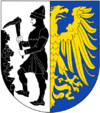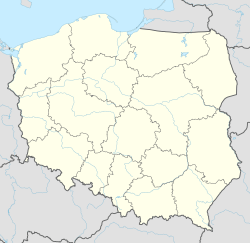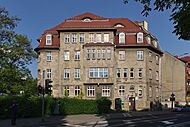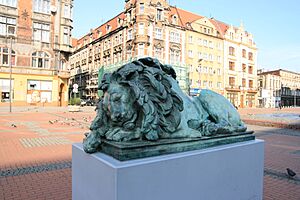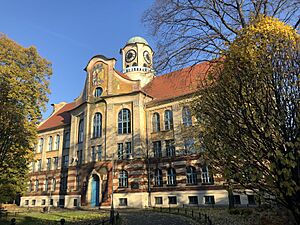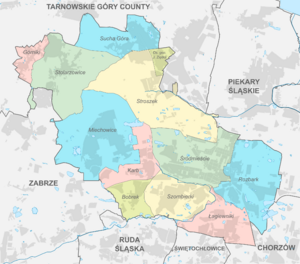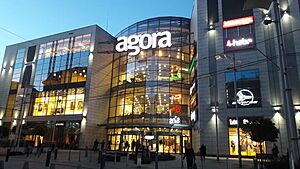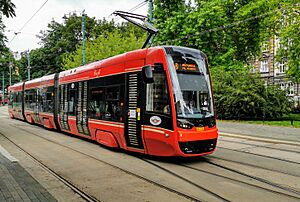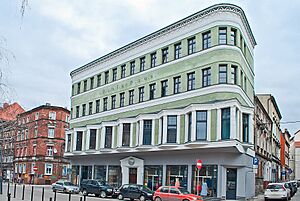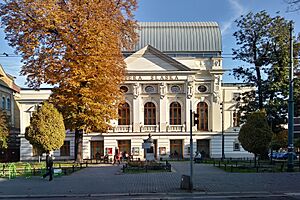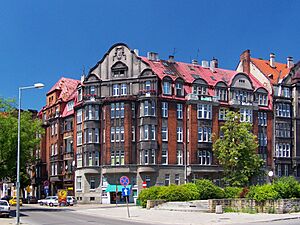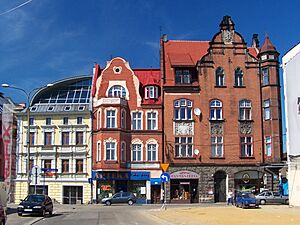Bytom facts for kids
Quick facts for kids
Bytom
Bytōm / Bytōń (Silesian)
|
|||
|---|---|---|---|
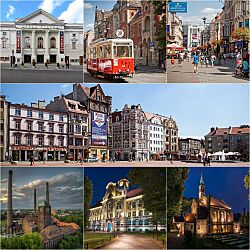
From top, left to right: Silesian Opera; Historic tram (in background Main Post Office); Dworcowa Street; Market square; Szombierki Heat Power Station; View of Władysław Sikorski Square; Church of St. Margaret
|
|||
|
|||
| Country | |||
| Voivodeship | Silesian | ||
| County | city county | ||
| Established | 12th century | ||
| City rights | 1254 | ||
| Area | |||
| • City | 69.44 km2 (26.81 sq mi) | ||
| Highest elevation | 330 m (1,080 ft) | ||
| Lowest elevation | 249 m (817 ft) | ||
| Population
(31 December 2021)
|
|||
| • City | 161,139 |
||
| • Density | 2,321/km2 (6,010/sq mi) | ||
| • Urban | 2,710,397 | ||
| • Metro | 5,294,000 | ||
| Time zone | UTC+1 (CET) | ||
| • Summer (DST) | UTC+2 (CEST) | ||
| Postal code |
41-900–41-936
|
||
| Area code(s) | +48 32 | ||
| Car plates | SY | ||
| Primary airport | Katowice Airport | ||
Bytom (pronounced like bee-tom) is an old city in Upper Silesia, a region in southern Poland. It's located in the Silesian Voivodeship (which is like a state or province) and is about 7 kilometers northwest of Katowice, the main city of the region.
Bytom is one of the oldest cities in Upper Silesia. It used to be the home of the Piast dukes, who were rulers of the Duchy of Bytom. For a long time, until 1532, the city was ruled by the Piast family. After that, it was controlled by the Hohenzollern family. From 1742 to 1945, Bytom was part of Prussia and then Germany. During this time, it became an important center for business and administration in the local industrial area.
Before World War II, Bytom was a key place for Polish people in Upper Silesia. They worked hard to keep their Polish identity alive through different groups and publications. During and after World War II, the city faced many changes.
| Historical population | ||
|---|---|---|
| Year | Pop. | ±% |
| 1950 | 173,955 | — |
| 1960 | 182,578 | +5.0% |
| 1970 | 187,500 | +2.7% |
| 1980 | 234,292 | +25.0% |
| 1990 | 231,206 | −1.3% |
| 2000 | 195,807 | −15.3% |
| 2010 | 181,617 | −7.2% |
| 2020 | 163,255 | −10.1% |
| source | ||
After World War II, Bytom focused a lot on developing heavy industries. This led to pollution and damage to the environment. Since 1989, the city has been going through a period of change, and its population has been decreasing since 1999. Despite these challenges, Bytom is still an important place for culture, entertainment, and industry in its region.
Contents
What Bytom is Like
Land and Resources
The ground in the Miechowice area of Bytom is mostly made of sandstones and slates. These rocks contain a lot of natural resources like coal and iron ore. In the northern part of Bytom, you can find different types of rocks, from sandstones to limestones. These areas are rich in zinc and lead. The top layer of the ground is made of clay, sand, and gravel.
City Symbol
The coat of arms of Bytom has two parts. One side shows a miner digging for coal, which represents the city's mining history. The other side shows a yellow eagle on a blue background. This eagle is a symbol of the Upper Silesia region.
Bytom's Past
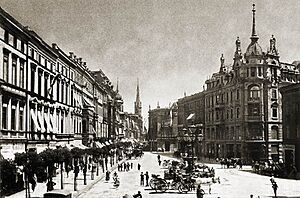
Bytom is one of the oldest cities in Upper Silesia. It was first mentioned in writing in 1136. At that time, it was part of the Kingdom of Poland. Archaeologists have found evidence of an old fortified settlement here. It was likely built by the Polish King Bolesław I the Brave in the early 11th century.
After Poland was divided into smaller parts in 1138, Bytom became part of the Seniorate Province. In 1177, it joined the Silesian part of Poland. Bytom officially became a city in 1254, when Prince Władysław gave it city rights. The city's first market square was built then. Bytom grew because it was on important trade routes. These routes connected Kraków with Silesia and Hungary with Moravia and Greater Poland.
The first Roman Catholic Church of the Virgin Mary was built in 1231. In 1259, the city was attacked by the Mongols. Later, Bytom became its own separate duchy in 1281. From 1289, it was under the rule of the Kingdom of Bohemia. This lasted until 1498, when it rejoined the Duchy of Opole. Over time, more German settlers came to the area, and the city started to become more German in its culture.
In 1526, Bytom came under the control of the Habsburg monarchy of Austria. This led to more German influence in the city. In 1683, the Polish King John III Sobieski and his wife visited Bytom. They were on their way to the Battle of Vienna. In 1742, Bytom became part of the Kingdom of Prussia during the Silesian Wars. Then, in 1871, it became part of the German Empire. During the 19th and early 20th centuries, Bytom grew quickly and became an industrial center.
Bytom was a key place for Poles who wanted to keep their culture and language strong against German influence. Many Polish social, political, and cultural groups were active here. A Polish newspaper, Dziennik Górnośląski, was published in Bytom starting in 1848. In 1863, Poles secretly moved gunpowder through Bytom to help the January Uprising in another part of Poland.
By 1905, most people in Bytom spoke German (59%), but a large number (38%) spoke Polish. In 1895, the "Sokół" Polish Gymnastic Society was formed. During the Silesian uprisings (1919–1920), Polish football clubs like Poniatowski Szombierki and Polonia Bytom were founded. These clubs later won national championships in Poland.
After World War I, people in Upper Silesia voted on whether to join Germany or Poland. In Bytom, 74.7% voted for Germany, and 25.3% voted for Poland. So, Bytom remained part of Germany. Even so, Bytom was one of only two cities in Germany where a Polish high school (gymnasium) was allowed to operate. A branch of the Union of Poles in Germany was also set up in Bytom in 1923. There was a Polish preschool, scout groups, and a Polish bank.
A secret German report from 1934 said that Bytom was a main center for the Polish movement in western Upper Silesia. Polish activists faced difficulties starting in 1937. The Bytom Synagogue was burned down by Nazi German groups during the Kristallnacht on November 9–10, 1938. Before 1939, Bytom was at the edge of German Silesia.
World War II and After
When Germany invaded Poland in 1939, starting World War II, many local Poles were arrested. On September 1, 1939, the head of the Union of Poles in Germany, Adam Bożek, was arrested in Bytom. He was later sent to a concentration camp. Germans searched the Polish high school and community center. Many Polish activists and teachers were arrested and sent to camps. The money from the Polish bank was taken. A special German unit entered Bytom on September 6, 1939, to carry out harsh actions against Poles. Many Poles from Bytom were forced to join the German army and died in the war. The Jewish community in Bytom was also destroyed, with people sent to Auschwitz-Birkenau.
During the war, the Germans ran a prison in Bytom with a forced labor camp. There were also several other forced labor camps within the city limits.
In 1945, after the war, Bytom became part of Poland again. This was decided at the Potsdam Conference. Most of the German population left, and Poles who had been forced to move from eastern areas joined the remaining Polish residents in Bytom.
In 2017, the Tarnowskie Góry Lead-Silver-Zinc Mine and its Underground Water Management System was added to the UNESCO World Heritage List. This mine is mostly in the nearby city of Tarnowskie Góry, but a part of it is also in Bytom.
Parts of Bytom
The city of Bytom is divided into 12 main areas, called Dzielnice in Polish. Here are some of them and when they became part of the city:
- Śródmieście (which means city center)
- Rozbark (1927)
- Bobrek (1951)
- Karb (1951)
- Łagiewniki (1951)
- Miechowice (1951)
- Szombierki (1951)
- Górniki (1975)
- Osiedle gen. Jerzego Ziętka (1975), also known as Sójcze Wzgórze
- Stolarzowice (1975)
- Stroszek (1975)
- Sucha Góra (1975)
Radzionków and Rojca were part of Bytom from 1975 until 1997, when they became a separate town again.
City Life
Economy and Business
Trade is a very important part of Bytom's economy. The city has a long history of business. Today, Bytom is becoming a modern center for trade and services. The city center, especially around Station Street and the Market Square, has the largest number of shops and businesses.
In 2007, Bytom and its neighboring cities formed the Upper Silesian Metropolitan Union. This was the largest urban area in Poland. In 2018, this group was replaced by Metropolis GZM.
Getting Around
Bytom has a tram system that helps people get around the city and to other nearby towns. These tram routes are run by a company called Tramwaje Śląskie S.A.
Sports in Bytom
Bytom is home to Polonia Bytom, a sports club with both football (soccer) and ice hockey teams. The football team played in Poland's top league and won the national championship twice, in 1954 and 1962. Another famous club from the Szombierki district, Szombierki Bytom, also won the Polish championship in 1980. It's one of the oldest sports clubs in the region. Other areas of the city have their own football clubs, like Rodło Górniki, founded in 1946.
Culture and Arts
Bytom has many places for culture and arts:
- Silesian Opera – a famous opera house.
- Miejska Biblioteka Publiczna w Bytomiu (City Public Library).
- Dance Theatre Rozbark in Bytom.
- Bytomskie Centrum Kultury (Bytom Cultural Centre).
- Kronika – Center of modern art.
- City Choir of St. Grzegorz Wielki.
There are also many art galleries in Bytom, showing different types of art.
Festivals
Bytom hosts several exciting festivals each year:
- Annual International Contemporary Dance Conference and Performance Festival.
- Theatromania – a Theatre Festival.
- Bytom Literary Autumn – a festival for books and writers.
- Festival of New Music – celebrating new music.
Learning and Education
Bytom has several universities and many secondary schools:
- Universities:
- Silesian University of Technology – with a Faculty of Transport.
- Medical University of Silesia.
- Polish Japanese Institute of Information Technology.
- Wyższa Szkoła Ekonomii i Administracji.
- Secondary schools:
- I Liceum Ogólnokształcące im. Jana Smolenia.
- II Liceum Ogólnokształcące im. Stefana Żeromskiego.
- IV Liceum Ogólnokształcące im. Bolesława Chrobrego.
- Plus 21 other secondary schools.
Famous People from Bytom
- Grzegorz Gerwazy Gorczycki (around 1665–1734), Polish composer.
- Heinrich Schulz-Beuthen (1838–1915), German composer.
- Ernst Gaupp (1865–1916), German anatomist.
- Ludwig Halberstädter (1876–1949), radiologist.
- Maximilian Kaller (1880–1947), bishop.
- Hermann Kober (1888-1973), Jewish-German mathematician.
- Kate Steinitz (1889–1975), German-American artist and art historian.
- Max Tau (1897–1976), Jewish-German-Norwegian writer.
- Henry J. Leir (1900–1998), American industrialist.
- Friedrich Domin (1902–1961), German film actor.
- Herbert Büchs (1913–1996), German General.
- Józef Kachel (1913–1983), head of the Polish Scouting Association.
- Horst Winter (1914–2001), German-Austrian jazz musician.
- Leo Scheffczyk (1920–2005), German theologian and cardinal.
- Bent Melchior(1929-2021) Chief Rabbi of Denmark.
- Haim Yavin (born 1932), Israeli news anchor.
- Wolfgang Reichmann (1932–1991), German actor.
- Józef Szmidt (born 1935), Polish triple jumper.
- Jan Liberda (1936–2020), Polish footballer.
- Jan Banaś (born 1943), Polish footballer.
- Walter Winkler (1943–2014), Polish footballer.
- Zygmunt Anczok (born 1946), Polish footballer.
- Jerzy Konikowski (born 1947), chess player.
- Leszek Engelking (born 1955), Polish poet and writer.
- Waldemar Legień (born 1963), Polish judoka, Olympic champion.
- Michał Probierz (born 1972), Polish football manager.
- Marcin Suchański (born 1977), Polish footballer.
- Marzena Godecki (born 1978), Australian actress.
- Dorota Kobiela (born 1978), Polish filmmaker.
- Paul Freier (born 1979), German footballer.
- Marek Suker (born 1982), Polish footballer.
- Gosia Andrzejewicz (born 1984), Polish pop singer.
- Martyna Majok (born 1985), Polish-American playwright.
- Weronika Murek (born 1989), Polish writer.
- Mariusz Wodzicki, Polish mathematician.
Sister Cities
Bytom has "sister city" relationships with other cities around the world. This means they share cultural and educational ties.
 Butte, United States
Butte, United States Drohobych, Ukraine
Drohobych, Ukraine Ormož, Slovenia
Ormož, Slovenia Recklinghausen, Germany
Recklinghausen, Germany Vsetín, Czech Republic
Vsetín, Czech Republic Zhytomyr, Ukraine
Zhytomyr, Ukraine
Images for kids
-
St. Hyacinth's Church – an example of Neo-Romantic architecture in Bytom
See also
 In Spanish: Bytom para niños
In Spanish: Bytom para niños



